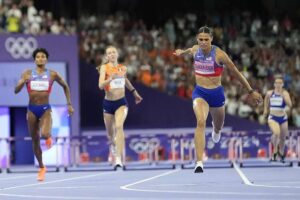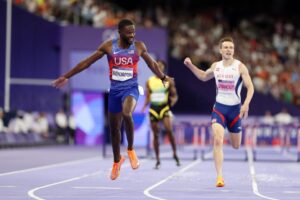The 400 Hurdles Greatness Continues
by Steve McGill
Whether we’re talking about World Championship years, an Olympic year, or a year with no major international championship meet, the 400 hurdles never fail to deliver something epic, on both the women’s side and the men’s side. While the 2021 Tokyo Olympics served as a pinnacle on the men’s side that the 2024 Paris Olympics didn’t match, we saw another world record from the astounding Sydney McLaughlin on the women’s side. Let’s take a look at both races, analyzing who did what and how. Let’s start with Sydney.
[am4show not_have=’g5;’]
[/am4show][am4guest]
[/am4guest][am4show have=’g5;’]
Women’s 400 Hurdles
Before we talk about the 400 hurdle final, let’s first take a look at the mixed 4×400 meter relay, as we really can’t talk about one without talking about the other. Personally, I still think of the mixed 4×4 as sort of a novelty race. One of those deals where it’s nice if you can win it but it’s not worth putting your best runners in it. Save them for the regular 4×4’s at the end of the meet. While Femke Bol has run the mixed 4×4 in the past, McLaughlin hasn’t, and no one really seemed to care one way or the other. But in the Olympics, everything is magnified because everyone is watching. And a large majority of the people watching don’t really know what they’re looking at or how to evaluate it because track is a sport they pay attention to only for one week every four years.
So on the anchor leg of the mixed 4×4, Bol performed a major walk-down of everybody in front of her after receiving the baton somewhere around fourth or fifth place. The last runner she walked down was US anchor leg Kaylyn Brown, whom she passed with about five meters to go. It was one of the most epic walk-downs in track and field history, as it cost the US a gold medal and earned the Netherlands a rare gold medal. Bol and her teammates were ecstatic after the race, and rightfully so. Brown looked a little bit dazed, and rightfully so. But that’s what Bol does. Outside of Sydney, she is the greatest 400 meter hurdler of all time. And along with Sydney, she could probably medal in the open 400 were she to choose to focus on that event.
The buzz I was hearing after the race, to my genuine surprise, did not focus just on Bol’s epic comeback, but almost just as much on the fact that Sydney hadn’t run the race. American fans especially seemed to be accusing Sydney of being a team player by not running the mixed relay. Seriously y’all? That’s all you got out of that?
What struck me as interesting is that even at the highest pinnacle of the sport, the Olympic Games, there is still the pressure for the best athletes to run in relays for the good of the team. Ironically, the pressure is even greater here because the “team” is the country. In high school, we load up our best athletes by putting them in a maximum number of events at the state meet. In college, a handful of superstar athletes can carry a team to a national title. And even at the international level, the best sprinters and hurdlers are expected to take part in relays, even if doing so could compromise their individual goals.
Getting to the actual 400 hurdle race, it seems obvious to me that not running the mixed 4×4 put Sydney at a significant advantage over Femke, simply because her legs and lungs weren’t as tired. Femke put everything into that 4×4 anchor leg, and it showed in the 400 hurdle final. In all the time I’ve seen Femke run the 400 hurdles, I’ve never seen her stutter, I’ve never seen her lose her rhythm, I’ve never seen her float over hurdles. She is as precise technically and rhythmically as any 400 hurdler in history (including Sydney in those regards). Yet in the 400 hurdle final in Paris we saw her stutter, we saw her lose her rhythm, we saw her float over a couple hurdles. By her standards, it was a disaster. If you ask me, none of that happens if she doesn’t run the mixed relay. The line is fine between great and very good, and putting too much on your body can compromise your greatness.

Sydney, meanwhile, was Sydney. She locked in, stone-faced, executed her race plan, stayed calm as she and Femke stayed even for the first half of the race, then switched into another gear and took over the race. Sydney is a stone cold killer on the track. A quiet, humble, loving, kind, God-fearing killer. Another day, another world record. Ho hum. She was even disappointed with her time, saying she had hoped to run even faster. Now the question is will she pursue a sub-50 in this race or will she seek to double up in the hurdles and the open 400. Or will she attempt to do both? In my mind, she’s already the greatest female track athlete in history, even if she were to retire today.
Finally, we can’t ignore Ana Cockrell’s remarkable performance, as she became the fourth-fastest 400 hurdler ever (behind Sydney, Femke, and Dalillah Muhammad) with her 51.87 for the silver medal. In third coming off the second turn, she roared past Femke on the homestretch while Femke stuttered, claiming the silver in a huge upset. Like everyone else, I was expecting a battle royale between Sydney and Femke, but Ana crashed the party and made her mark in the annals of history.
Men’s 400 Hurdles
I’m a big believer in following the arc of a season when predicting who will win an Olympic or World Championship final. While it’s important to look at who is looking sharpest throughout the rounds, it also helps to look at the entirety of the season up to that point. This year, the three big dogs from the 2021 Olympics – Karsten Warholm, Rai Benjamin, and Alison Dos Santos – were still the three big dogs heading into the 2024 Olympics.
But the hierarchy had shifted. In 2021, Warholm was a juggernaut. With his pre-race Viking roar and beating of the chest, he was as intimidating a figure as the sport has ever seen. Think about it – Rai ran 46.17 in that 2021 Olympic final – a time that nobody has matched since – and he finished second. Karsten’s 45.94 in that race remains and will long remain one of the most stunning performances in track and field history. If he, Rai, nor Alison have been able to run faster since then, there’s a good chance that world record is going to last a long time.
But we’ve seen some cracks in Karsten’s armor since then. In 2022, Alison emerged as world champion as Karsten and Rai both struggled with injury and inconsistency. In 2023, Karsten reclaimed his spot at the top with a World Championship victory. In the early outdoor season of 2024, Karsten was again looking like his old self, but Rai and Alison were looking equally as strong, if not stronger. Then there was the Diamond League meet in July, a couple weeks before the start of the Games, where Rai defeated both Karsten and Alison. That’s when I said to myself, this is looking like Rai’s year. Obviously, you could argue that none of them were bringing their A-game knowing that they would need to do so when racing against each other a few weeks later, but I would also argue that none of them wanted to lose, that all of them wanted to send a message to the others. There’s something psychologically validating about crossing the line before one’s competitors, so Rai went into the Games with that slight psychological edge. But with Karsten being Karsten, there remained a good chance that he’d prove that Diamond League meet to be meaningless. And with Alison being a 6-7 long-strider who 12-steps half the race, there was always the chance he could overtake both rivals and emerge as the new big dog.
As it turned out, my “arc of the season” theory proved correct in this case. In the semifinals, all three hurdlers finished in the 47’s, with Karsten being the fastest of the three, as he and Alison ran in the same semifinal heat. Clement Ducos of France was also in that heat, and finished slightly ahead of Alison.

In the final, there were a total of six athletes under 48-flat (I’m pretty sure that has never happened before), but only one ran under 47 – Rai Benjamin. His winning time of 46.46 wasn’t as fast as his race in Tokyo in 2021, but it was every bit as impressive. I guess the one disappointing thing was that this final did not prove to be the spectacular showdown many of us were anticipating it to be. Rai pretty much dominated this race. It looked to me that when Rai passed Karsten around hurdle seven, Karsten tried too hard to pass him back immediately, as he lunged and stretched to maintain his 13-stride pattern when he probably should’ve changed down to 14. By reaching for 13 at hurdle eight, he used up a lot of energy and ended up 15-stepping the last two barriers. Alison, meanwhile, never seemed to hit the high gears we had seen him hit earlier in the year, when he was running sub-47 easily way back in May. Maybe he peaked too soon? Hard to tell. But his 47.26, despite how fast that is, was a letdown when considering how fast he has run in the past.
Finally, let’s take note that Trevor Bassitt of the US proved to be the victim of being in a super-fast semifinal heat, as his 48.29 did not make the final, as he finished behind Karsten, Alison, and Clement Ducos. His time was faster than the second-place time in the third semifinal heat. That should tell you just how loaded with talent this event is.
(I wasn’t able to embed race footage into this article due to copyright restrictions).
[/am4show]
